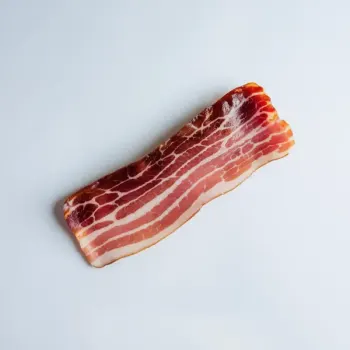Bacon and Pancetta are both salt-cured pork products, with bacon being smoked and Pancetta remaining unsmoked, offering distinct flavors and textures ideal for a variety of dishes from breakfast to pastas and soups.

Bacon is a type of salt-cured pork made from various cuts, typically from the pork belly or from back cuts, which have less fat than the belly. It is eaten on its own, as a side dish, or used as an ingredient to flavor dishes.

Pancetta is an Italian type of salt-cured meat made from pork belly. It is similar to bacon but is typically not smoked. It's used as a flavor component in many Italian dishes, either on its own or to add depth to sauces, soups, and pastas.
While both bacon and pancetta are made from pork belly, bacon is usually smoked after being cured, which gives it a distinctive smoky flavor. Pancetta, on the other hand, is generally not smoked and has a more subtle, porky flavor. The texture of bacon is also often crisper due to the smoking process, whereas pancetta remains tender and smooth. Additionally, the curing process and spices used can vary between the two, with pancetta often using a blend of spices that impart a different flavor profile.

Your ultimate Recipe Box, Meal Planner, and Cooking Class all in one
Bacon is a staple in many breakfast dishes, from classic bacon and eggs to being a crispy addition to breakfast sandwiches and pancakes. Its smoky flavor and crisp texture provide a savory contrast to the often milder flavors of traditional breakfast foods. Pancetta can also be used in breakfast dishes as a subtler alternative to bacon. It pairs well with eggs, in omelets, or as part of a sophisticated eggs Benedict. Its delicate flavor can elevate a simple breakfast to something more gourmet.
Bacon's smoky flavor can add a robust depth to pasta dishes, particularly in recipes like spaghetti carbonara or in a hearty bacon mac and cheese. The crispness of fried bacon also provides an appealing texture contrast. Pancetta is traditionally used in many Italian pasta dishes such as pasta all'amatriciana or carbonara, where its rich flavor infuses the dish without overwhelming it. It's particularly well-suited for creamy sauces or dishes that benefit from a subtle pork flavor.
In soups and stews, bacon can be used to impart a smoky base flavor. It works well in dishes like split pea soup, potato soup, or in chowders where its smokiness complements the other ingredients. Pancetta is often used in Italian soups and stews, such as minestrone or lentil soup, to add a depth of flavor. It melds well with the other ingredients without overpowering them, enhancing the overall taste of the dish.
Both bacon and pancetta are high in fat and should be consumed in moderation for a balanced diet.
| Nutrient | Bacon ( per Ounce ) | Pancetta ( per Ounce ) |
|---|---|---|
| Fat | 12g | 9g |
| Sodium | 620mg | 480mg |
| Calcium | 3mg | 0mg |
| Protein | 10g | 7g |
| Calories | 151 | 108 |
| Carbohydrates | 0.5g | 0g |
Yes, pancetta can often be used as a substitute for bacon, but keep in mind that it will not impart the same smoky flavor that bacon would.
Both pancetta and bacon are cured pork products and are high in fat and sodium, so neither is considered 'healthy' in large amounts. However, the nutritional content can vary, so it's best to compare labels and consume them in moderation.
Yes, pancetta should be cooked before consumption, even though it's cured, as cooking will bring out its best flavor and ensure it is safe to eat.
Yes, you can use bacon as a substitute for pancetta in Italian recipes, but the dish will have a smokier flavor profile.
Both bacon and pancetta should be stored in the refrigerator. Unopened, they can last for weeks; once opened, they should be used within a week, or they can be frozen for longer storage.